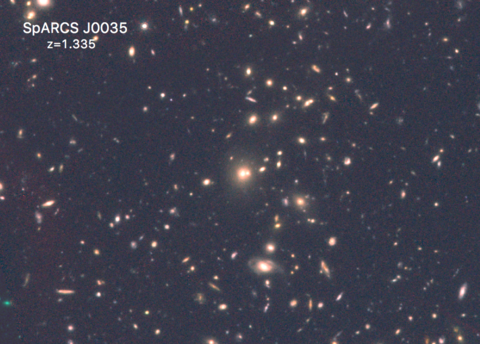
Riverside, Ca –
Galaxy clusters are rare regions of the universe consisting of hundreds of galaxies containing trillions of stars, as well as hot gas and dark matter.
It has long been known that when a galaxy falls into a cluster, star formation is fairly rapidly shut off in a process known as “quenching.” What actually causes the stars to quench, however, is a mystery, despite several plausible explanations having been proposed by astronomers.
A new international study led by astronomer Ryan Foltz, a former graduate student at the University of California, Riverside, has made the best measurement yet of the quenching timescale, measuring how it varies across 70 percent of the history of the universe. The study has also revealed the process likely responsible for shutting down star formation in clusters.
Each galaxy entering a cluster is known to bring some cold gas with it that has not yet formed stars. One possible explanation suggests that before the cold gas can turn into stars, it is “stripped” away from the galaxy by the hot, dense gas already in the cluster, causing star formation to cease.

Another possibility is that galaxies are instead “strangled,” meaning they stop forming stars because their reservoirs cease getting replenished with additional cold gas once they fall inside the cluster. This is predicted to be a slower process than stripping.
A third possibility is that energy from the star formation itself drives much of the cold gas fuel away from the galaxy and prevents it from forming new stars. This “outflow” scenario is predicted to occur on a faster timescale than stripping, because the gas is lost forever to the galaxy and is unavailable to form new stars.
Because these three different physical processes predict galaxies to quench on different relative timescales over the history of the universe, astronomers have postulated that if they could compare the number of quenched galaxies observed over a long time-baseline, the dominant process causing stars to quench would more readily become apparent.
However, until recently, it was very difficult to find distant clusters, and even harder to measure the properties of their galaxies. The international Spitzer Adaptation of the Red-sequence Cluster Survey, or SpARCS, survey has now made a measurement of more than 70 percent of the history of the universe, accomplished by pioneering new cluster-detection techniques, which enabled the discovery of hundreds of new clusters in the distant universe.

Using some of their own newly discovered SpARCS clusters, the new UCR-led study discovered that it takes a galaxy longer to stop forming stars as the universe gets older: only 1.1 billion years when the universe was young (4 billion years old), 1.3 billion years when the universe is middle-aged (6 billion years old), and 5 billion years in the present-day universe.
“Comparing observations of the quenching timescale in galaxies in clusters in the distant universe to those in the nearby universe revealed that a dynamical process such as gas stripping is a better fit to the predictions than strangulation or outflows,” Foltz said.
To make this state-of-the art measurement, the SpARCS team required 10 nights of observations with the W. M. Keck Observatory telescopes (10 meters in diameter) in Hawaii, and 25 nights of observations with the twin Gemini telescopes (8 meters in diameter) in Hawaii and Chile.
“Thanks to the phenomenal investment in our work by these observatories, we now believe we have a good idea of how star formation stops in the most massive galaxies in clusters,” said Gillian Wilson, professor of physics and astronomy at UCR and leader of the SpARCS survey, in whose lab Foltz worked when the study was done. “There are good reasons, however, to believe that lower-mass galaxies may quench by a different process. That is one of the questions our team is working on answering next.”

The team has been awarded 50 additional nights of Gemini time and a $1.2 million grant from the National Science Foundation to study how star formation stops in more regular-mass galaxies. Wilson was also awarded Hubble Space Telescope observations and a NASA grant to analyze high-resolution images of the quenching galaxies.
The research paper is published in the Astrophysical Journal and can be found here.
The W. M. Keck Observatory findings were obtained as the result of a collaboration amongst UC faculty members Gillian Wilson (UCR), Michael Cooper (UC Irvine) and Saul Perlmutter (UC Berkeley). Other authors involved in the study were Adam Muzzin (University of York, Canada), Julie Nantais (Andres Bello University, Chile), Remco van der Burg (European Southern Observatory, Germany), Pierluigi Cerulo (Universidad de Concepción, Chile), Jeffrey Chan (UCR), Sean Fillingham (UCI), Jason Surace (California Institute of Technology), Tracy Webb (McGill University, Canada), Allison Noble (MIT), Mark Lacy (National Radio Astronomy Observatory), Michael McDonald (MIT), Gregory Rudnick (University of Kansas), Ricardo Demarco (Universidad de Concepción, Chile), Christopher Lidman (Australian Astronomical Observatory), Julie Hlavacek-Larrondo (University of Montreal), Howard Yee (University of Toronto, Canada), and Brian Hayden (UCB).
The study was supported by grants from NSF and NASA.
Let us help you with your search